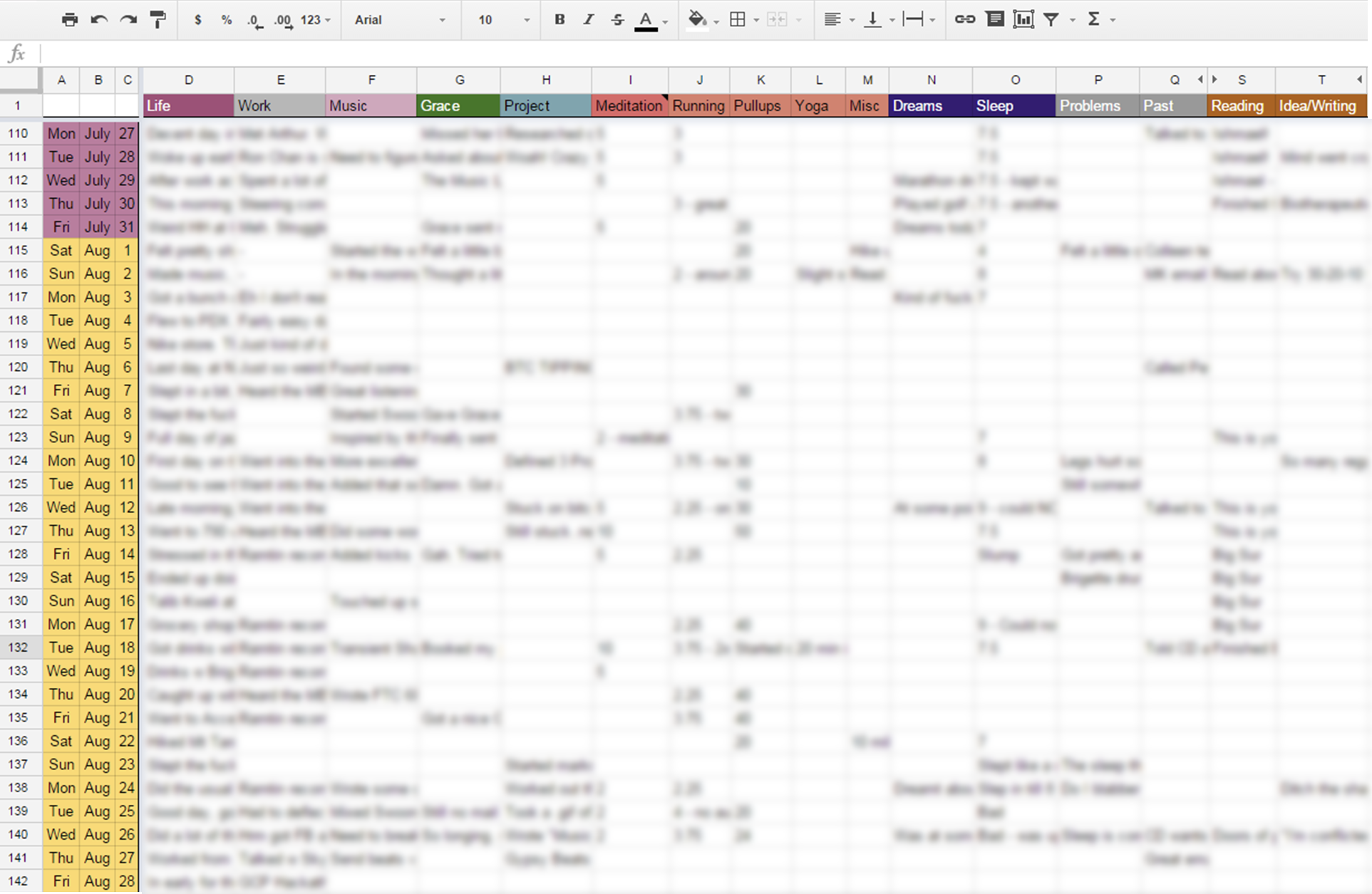Make Every Day Matter
October 1, 2015
Would you be able to describe what you were doing two Tuesdays ago? How about on this day two years ago? It is alarming how quickly our time can go by with little to show for it. Over the last year I’ve been experimenting with a tool that blends the functions of a journal, calendar, and goal tracker. It helps me be more productive and mindful of the many facets of my daily life. It is flexible, personalized, and easy to access and update. In just a few minutes, with nothing more than a Google Spreadsheet, you can set this tool up too. Here’s mine:

My tracker from the end of July to the end of August
I blurred the content out because it is very personal, as it should be! You’ll notice a few things from the snapshot above:
- I use a Google Spreadsheet for this tool.
- Column headers are categories of activities, rows are dates.
- Cells contain content. It can be a simple number or some text.
Google Sheets are great because I can update them from any device, including my phone. They are always backed up on the cloud, and have all the functionality necessary to create and maintain this tool.
I am also aware of other niche tools for goal tracking. MyFitnessPal provides a lot of great features for tracking calories and exercise, for instance. Many of you may be familiar with Mint, a personal finance application. Some of these tools are great and offer useful features, others are simply not effective. Those products can definitely be combined with this method — they would simply take the place of one or more columns in your spreadsheet. Everyone will have a different set of tools that work for them, so it is important to experiment.
Columns represent daily activities that are important to you. These have changed a lot for me throughout the past year, and I intend to continue to shape the categories that I track. It is also helpful to freeze the column and row headers so that they always remain visible (View > Freeze). Ultimately what you decide to include as columns should be a personal matter based on your goals, habits, and lifestyle - but here are a few suggestions based on my experiences:
- Life & Work. Many of us feel the push-and-pull of our work/life balance. My “Life” column is kind of like a personal journal. It’s great for listing miscellaneous, new, or exciting things I did during the day. The “Work” column is useful over time for tracking your professional contributions and development.
- Significant Other. If you have a S/O, make a column for them. List the things you do together, what you talk about, and how you feel about it all. You’ll be a better partner for doing so, and reading through past entries will evoke a range of potent emotions.
- Projects. I keep separate columns for “Music” and “Projects”. Although I am always working on side projects here and there, making music is so important to me that it warrants its own column. If you have a similar passion, make sure it gets the proper real estate.
- Health. make a separate category for each exercise you regularly engage in, or aim to engage in. This is a great motivation for getting up and out.
- Sleep. the CDC has labeled insufficient sleep a public health problem. Whether you hope to get up earlier, sleep more, or sleep better, tracking your progress will help immensely. Sometimes I simply list the hours of sleep that I got the night before, other times I write more descriptive notes.
- Problems. what’s bugging you, and why? Being honest with yourself is important. Writing down the things that you want to work on will help you get to where you need to be.
- Past. In 2014 I moved from Virginia to California, so I made this column as a motivator for staying in touch with friends and family.
- Reading & Writing. I can’t stress how important these habits are! Reading a book is like being in someone else’s mind. Writing helps you develop coherent thoughts. Both will help you be a better person.
Finally, let’s talk about what goes in those cells. One of my issues with traditional journal writing is that I get caught up in syntax, grammar, or word choice. So when I fill in a cell I make it concise and short. I first answer the question “what did I do today that relates to the column heading” in as few words as possible, almost in bullet point style. Don’t worry about writing complete sentences. Like I said, you can even just type numbers, like “4”, to represent how many miles you ran under the “running” category.
Sometimes, I will reflect on what I did on a given day. I may have had a nice time running in a new neighborhood, in which case I would make a note of it next the number of miles I ran. Writing your reflections down makes them less fleeting and more actionable
You may have noticed that there is a lot of white space in my spreadsheet. That’s because it’s really hard to do something every day, and to take the time to write it down (though I only spend around 5 minutes each day updating the spreadsheet). Regardless of how well you are meeting your goals, being able to visualize your progress is essential to improvement. Scrolling back in time through my spreadsheet gives me a sense of satisfaction and motivation, because I can literally see myself becoming who I want to be. I have something to show, no matter how small, for every single day of my life.
This piece was originally published on October 1, 2015 on Medium